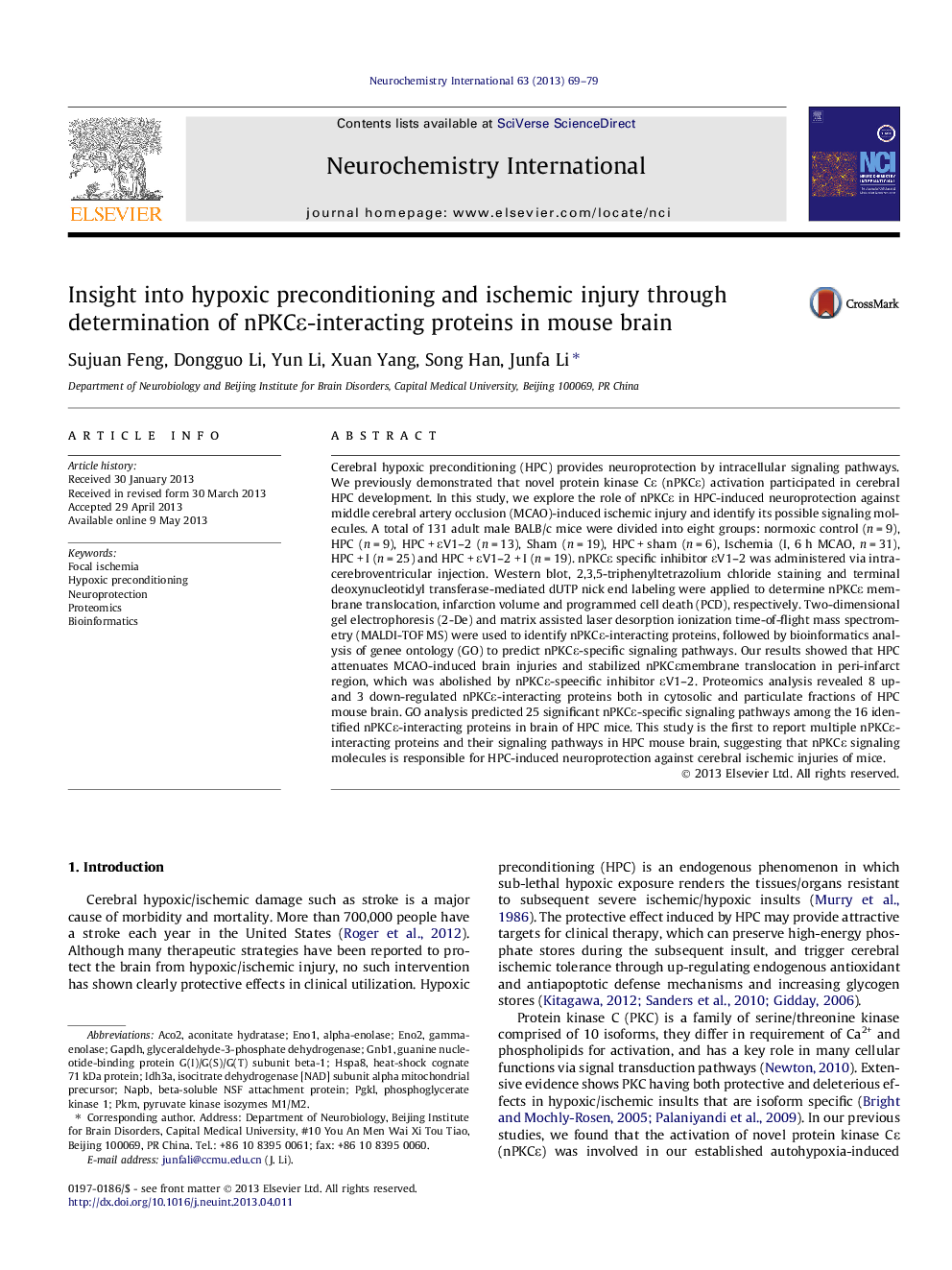| کد مقاله | کد نشریه | سال انتشار | مقاله انگلیسی | نسخه تمام متن |
|---|---|---|---|---|
| 2200734 | 1099967 | 2013 | 11 صفحه PDF | دانلود رایگان |

• HPC stabilizes nPKCε membrane translocation in peri-infarct region of MCAO mice.
• HPC attenuates MCAO-induced ischemic injuries, which was abolished by nPKCε inhibitor εV1-2.
• Proteomics analysis reveals 8 up- and 3 down-regulated nPKCε-interacting proteins in HPC mouse brain.
• Bioinformatics analysis predicts 25 significant nPKCε-specific pathways during cerebral HPC.
• This study provides an insight into the molecular mechanism of cerebral HPC and ischemic injury.
Cerebral hypoxic preconditioning (HPC) provides neuroprotection by intracellular signaling pathways. We previously demonstrated that novel protein kinase Cε (nPKCε) activation participated in cerebral HPC development. In this study, we explore the role of nPKCε in HPC-induced neuroprotection against middle cerebral artery occlusion (MCAO)-induced ischemic injury and identify its possible signaling molecules. A total of 131 adult male BALB/c mice were divided into eight groups: normoxic control (n = 9), HPC (n = 9), HPC + εV1–2 (n = 13), Sham (n = 19), HPC + sham (n = 6), Ischemia (I, 6 h MCAO, n = 31), HPC + I (n = 25) and HPC + εV1–2 + I (n = 19). nPKCε specific inhibitor εV1–2 was administered via intracerebroventricular injection. Western blot, 2,3,5-triphenyltetrazolium chloride staining and terminal deoxynucleotidyl transferase-mediated dUTP nick end labeling were applied to determine nPKCε membrane translocation, infarction volume and programmed cell death (PCD), respectively. Two-dimensional gel electrophoresis (2-De) and matrix assisted laser desorption ionization time-of-flight mass spectrometry (MALDI-TOF MS) were used to identify nPKCε-interacting proteins, followed by bioinformatics analysis of genee ontology (GO) to predict nPKCε-specific signaling pathways. Our results showed that HPC attenuates MCAO-induced brain injuries and stabilized nPKCεmembrane translocation in peri-infarct region, which was abolished by nPKCε-speecific inhibitor εV1–2. Proteomics analysis revealed 8 up- and 3 down-regulated nPKCε-interacting proteins both in cytosolic and particulate fractions of HPC mouse brain. GO analysis predicted 25 significant nPKCε-specific signaling pathways among the 16 identified nPKCε-interacting proteins in brain of HPC mice. This study is the first to report multiple nPKCε-interacting proteins and their signaling pathways in HPC mouse brain, suggesting that nPKCε signaling molecules is responsible for HPC-induced neuroprotection against cerebral ischemic injuries of mice.
Figure optionsDownload as PowerPoint slide
Journal: Neurochemistry International - Volume 63, Issue 2, August 2013, Pages 69–79